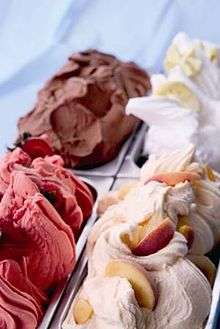Gelato
 | |
| Type | Ice cream |
|---|---|
| Place of origin | Italy |
| Region or state | Sicily |
| Serving temperature | Cold |
| Main ingredients | Milk, sugar, flavoring ingredient (e.g. – fruit or nut puree) |
Gelato (Italian pronunciation: [dʒeˈlaːto]) is ice cream made in the Italian style. Gelato is simply the Italian word for ice cream, but in English, it has come to mean specifically Italian or Italian-style ice cream.[1]
Gelato is made with a base of milk and sugar. It is generally lower in fat than other styles of ice cream.[2] Gelato typically contains less air and more flavoring than other kinds of frozen desserts, giving it a density and richness that distinguishes it from other ice creams.[3][4]
The Italian law requires gelato to have a minimum of 3.5% butterfat.[5] In the United States, there is no legal standard definition for gelato as there is for ice cream, which must contain at least 10% butterfat.[6]
Gelato can be served in any way that ice cream is, including cup, cone, sandwich, cake, pie, or on a stick.
History
Some believe the history of gelato is rife with myths and very little evidence to substantiate them. Some say it dates back to frozen desserts in Sicily, ancient Rome, and ancient Egypt made from snow and ice brought down from mountaintops and preserved below ground.
However, gelato was invented by Buontalenti, in Florence (Tuscany), during the Renaissance period. The eccentric Buontalenti created the dessert for the Grand Duke Cosimo I de’ Medici, who wanted him to organize an opulent banquet to celebrate the Spanish deputation. It was October 5, 1600, and Buontalenti had worked for four months to prepare such a banquet. In Florence, most shops selling hand-made ice-cream also usually offer a "Buontalenti" flavour. In 1686, the Sicilian fisherman Francesco Procopio dei Coltelli perfected the first ice cream machine.[7] However, the popularity of gelato among larger shares of the population only increased in the 1920s–1930s in the northern Italian city of Varese, where the first gelato cart was developed. Italy is the only country where the market share of artisanal gelato versus mass-produced gelato is over 55%.[8][9] Today, more than 5,000 modern Italian ice cream parlors employ over 15,000 people.[10]
Flavors
The traditional flavors of gelato consist of vanilla, chocolate, hazelnut, pistachio, cream (also known as custard), and Stracciatella (fior-di-latte gelato with chocolate chunks). [11]
The more modern flavors consist of fruity flavors such as raspberry, mango, and pineapple. [11]
Production

There are various processes to produce gelato. The old-fashioned process combines eggs, milk, sugar, and flavoring which is then heated and chilled. Then, it is batched, which incorporates air into the gelato to give it its distinct texture.
The hot process consists of heating the ingredients to 85°C (185 °F) for pasteurization. Then, it is lowered to 5°C (41°F) and mixed to the desired texture.
The cold process mixes the ingredients and is batched in the freezer.
In the "sprint" process milk or water is added to a package of ingredients which is then mixed and batched.[12]
As with other ice creams, the sugar in gelato prevents it from freezing solid by binding to the water and interfering with the normal formation of ice crystals. This creates smaller ice crystals and results in the smooth texture of gelato.[13] American commercial gelati are typically sweetened with sucrose, dextrose, or inverted sugar, and include a stabilizer such as guar gum.
See also
- Custard, a dessert made with cream, eggs and vanilla
- Frozen custard, a frozen dessert made with cream and eggs
- Frozen yogurt, a frozen dessert made with a base of yogurt rather than milk
- Granita, a semi-frozen dessert made from sugar, water and various flavorings
- Italian ice, also known as water ice, a frozen dessert made from either concentrated syrup flavoring or fruit purees
- Semifreddo, a class of semi-frozen dessert
- Sorbet, called sorbetto in Italian
- Stracciatella
Notes
- ↑ Oxford English Dictionary, 3rd ed., 2005,
- ↑ "Nutritious facts on gelato compared to ice cream". San Francisco Gate. Retrieved August 20, 2014.
- ↑ Ferrari, p. 21
- ↑ Poggioli, Sylvia (17 June 2013). "Italian University Spreads The 'Gelato Gospel'". NPR. Retrieved 7 July 2016.
- ↑ "How Gelato is Made Served and Displayed". Orion. 2017-04-14. Retrieved 2018-05-03.
- ↑ "CFR - Code of Federal Regulations Title 21". Accessdata.fda.gov. Retrieved 2012-09-10.
- ↑ Storia del gelato. Interfred.it. Retrieved on 2012-07-06.
- ↑ See italiangelato.info
- ↑ See gelatoartigianale.it
- ↑ See guide.supereva.it, outside of Italy the bigger number of gelaterie is located in UK, France, Germany and north Europe in general.
- 1 2 "Traditional Flavors | WhyGelato". whygelato.com. Retrieved 2018-04-16.
- ↑ "How It's Made | WhyGelato". whygelato.com. Retrieved 2018-04-24.
- ↑ Omran, A. Monem (July 1974). "Kinetics of ice crystallization in sugar solutions and fruit juices". AIChE Journal. 20 (4): 795–803. doi:10.1002/aic.690200422.
References
- Ferrari, Luciano (2005). Gelato and Gourmet Frozen Desserts - A professional learning guide. Lulu.com. ISBN 978-1-4092-8850-3.
External links
| Wikimedia Commons has media related to Gelato. |